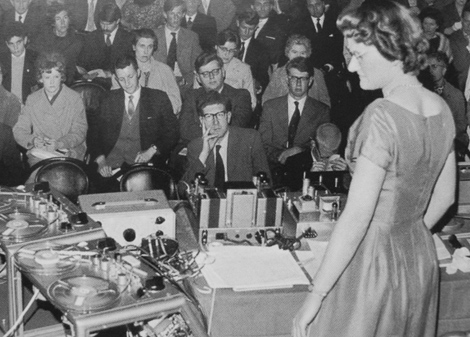
Daphne Oram
“You take a sound, any sound, record it and then change it’s nature by a multiplicity of operations. You record it at different speeds; you play it backwards; you add it to itself over and over again. You adjust filters, echoes, acoustic qualities…you produce a vast and subtle symphony. It’s a sort of modern magic. We think there’s something in it. Some musicians believe it may become an art form in its own right….” Daphne Oram, 1957[1]
Aural extremity; disregard of tradition; friction with the musical establishment; the twisting of technology in daring new ways: the story of early electronic music was — by its nature and from the start — one of boundless sonic exploration. Often conducted by obsessive visionaries, it encompassed everything from the subtle manipulation of field recordings to precise waveform synthesis. And while modern electronic dance music is intrinsically connected to club culture, with 1974 (and the dawn of Kraftwerk) often cited as something of a “year zero” for electronic music, this fascinating earlier continuum stretches back over a century.
The subject is a large and complex area: it will no doubt continue to fuel academic research well into this century. As such, this piece does not purport to be anything approaching a comprehensive — or indeed a linear — history. Rather it’s a primer in spirit — an appetizer that hopes to encourage independent exploration. As such, the focus will be on three of the most exciting movements: the mischievous and organic experimentation of Musique Concrète; the austere and disciplined early synthesis of Elektronische Musik; and the sinister hallucinatory audio of the BBC Radiophonic Workshop.
Early Background
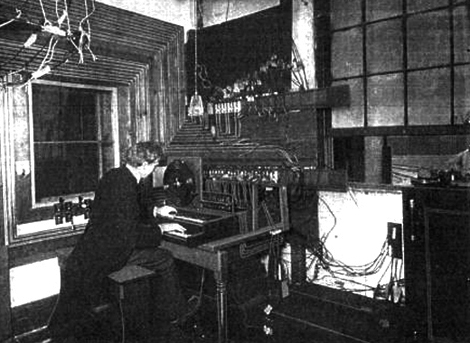
Thaddeus Cahill’s Telharmonium
Brutally industrial by design, the first use of electronics to produce music was in 1902. It came in the form of Thaddeus Cahill’s foreboding Telharmonium machine: a sprawling and forbiddingly heavy (200 ton) network of dynamos producing hums of opposing tones according to the speed at which they spun. But while this was a musical product of the industrial age made flesh, other important innovations took a purely philosophical approach, especially in the vibrant philosophical hothouse of early 20th century Italy.
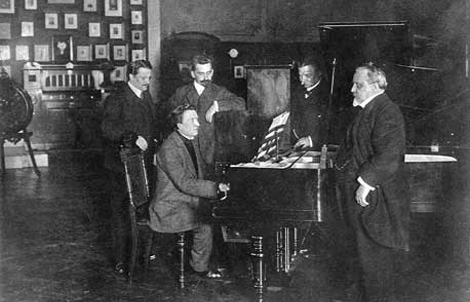
Ferruccio Busoni, seated
Italian Futurist Ferruccio Busoni published his Sketch of A New Esthetic of Music in 1907:
“There is nothing properly modern only things that have come into being earlier or later. The modern and the old have always been…. However deeply rooted the attachment to the habitual, and inertia, may be in the ways and nature of humankind, in equal measure are energy, and opposition to the existing order.”[2]
Indeed, the influence of the Italian Futurist movement was instrumental in helping shift musical theory sideways. Discussion on the nature of sound had opened up: the very fabric of what constituted music — codified, studied and rationalized for centuries — was now under debate. The Art of Noises, written by Luigi Russolo in 1913, has become an iconic text, both for music theorists and counter cultural adventurers alike.
“The most complicated of orchestras reduce themselves to four or five classes of instruments differing in timbre. We must break out of this narrow circle of pure musical sounds and conquer the infinite variety of noise sounds. Indeed noise is differentiated from musical sound merely in that the vibrations that produce it are confused and irregular… Away! Let us break out since we cannot much longer restrain our desire to create finally a new musical reality, with a generous distribution of resonant slaps in the face, discarding violins, pianos, double basses, and plaintive organs. Let us break out!”[3]
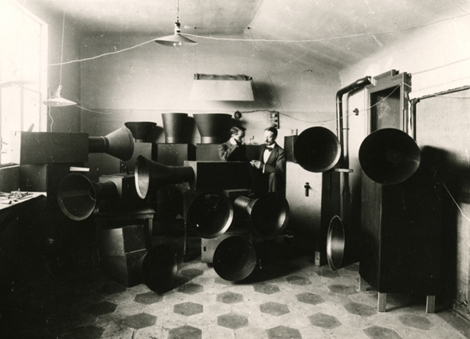
Luigi Russolo and his Intonarumori
Russolo’s ideas were not simply confined to the page — they were realized in spectacular fashion. He invented a raucous and bizarre selection of noise-generating instruments, the Intonarumori. The Intonarumori were used to create a wild variety of sounds through ingenious mechanical means: one of them imitated the sound of an engine starting, another gentle whispers, and another violent screams. Each relied on a complex system of levers, wires, pulleys — fantastical industrial apparatus like something from a Jules Verne novel — housed in large wooden boxes. A selection of these was performed in collaboration with the percussionist Ugo Piatti as “The Art of Noises” in Milan in 1913.
However, it was not until the late 1940s that the idea of utilizing the musical potential of everyday noises, pushing conceptual sound design to the forefront of art, that a new aesthetic of music — one with electronics at its core — was to become widely acknowledged.
Musique Concrète
“I was involved in music; I was working with turntables (then with tape-recorders); I was horrified by modern 12-tone music. I said to myself, ‘Maybe I can find something different… maybe salvation, liberation, is possible.’” Pierre Schaeffer [4]
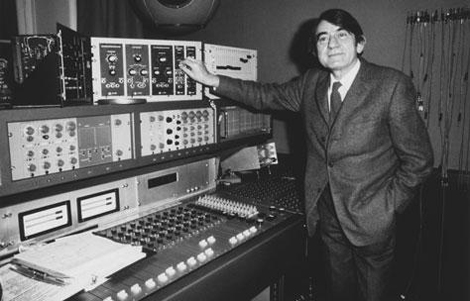
Pierre Schaeffer in his studio, 1954
Musique Concrète suspended the acoustic apparatus of daily life, removing it from imbedded familiarity and unlocking the secret acoustic potential of the noises that surround us. Doors slamming, footsteps and rain, rail platform announcements, thunderstorms, laughing, crying, all were used to create startlingly vibrant new music. Put simply, Musique Concrète can be described as music made largely from “found” sound — field recordings, in today’s vernacular — a particularly ingenious form of proto sampling. Pierre Schaeffer, an audio engineer and broadcaster, and Pierre Henry, a composer, were the main protagonists of the movement.
Schaeffer was an audio engineer at the Radiodiffusion Television Françaises (RTF) — France’s main television studio — in the 1940′s, and it was in the later part of that decade he initiated new sound experiments, striking percussion instruments with differing degrees of force and pondering the results. This led him to the all-important observation that any single musical event is characterized just as much by attack and decay as it by timbre.[5]
He labelled sound sources as “L’objet sonore” (the sound object). In effect, this represented a large-scale democratization around audio. The thinking was that sound could always be broken down into three areas — amplitude (loudness), frequency (tone), and time (duration) — and these three areas could be applied to any sound, musical or otherwise. Schaeffer also made a clear division between “human” and “non human” sounds. For example, a “human” sound may be shouting or whistling, primary noise derived directly from the body. Somewhat confusingly, “non human” sounds might be what Schaeffer saw as secondary noise, also derived from the body, such as footsteps or traditional musical sounds — piano, percussion and the like. He then wrote distinct musical “plans” that a producer of Musique Concrète could undertake, once sounds had been selected. These were as follows:
The Harmonic Plan: or working with timbre (tone quality) across the available range of frequencies
The Dynamic Plan: working with sound dynamics; loudness; envelope
The Melodic Plan: the development of pitch and tone sequences over time[6]
Schaeffer was wildly productive, tireless in his search for new means of manipulating sound material. His work as a radio engineer had raised his competence with devices such as turntables, mixers and disc cutting lathes. The turntable, in particular, was to prove fundamental in the recording of early pieces of Musique Concrète, as the tape recorder — later used to perform multiple recording and editing functions — was not yet in use.
The idea of the “locked groove repetition” was also central. Edits had to be performed in real-time during recording. Repetitions of individual sounds — vocal fragments, for example — were obtained by recording directly onto disc lathes which, when played back, had the same effect as a phonographic stylus repeating the same groove over and over. These could then be further manipulated once they’d been cut.[7] This methodology was markedly different from traditional composition, whereby a composer would write musical notes on paper for reproduction by a musician or orchestra.
Under the auspices of Musique Concrète, the sounds are already in existence; a parallel can be drawn with the sculptor, chipping away at a hunk of rock to unearth the artwork. For the first time the role of the engineer — a term previously only associated with science and industry — was of central importance to music. So, in Musique Concrète the music made was not “performed” as previous electronic experiments such as Russolo’s “Art of Noises” had been. Rather, the final piece was captured, manipulated, and composed purely through technological means. The playback itself was the performance — rather like a DJ set — and the means of production was of paramount importance: composer, engineer, and producer were one and the same, the mastery of new technology akin to the mastery of a musical instrument.
“Etude Aux Chemins De Fer” was Schaeffer’s first recorded piece of Musique Concrète, assembled using field recordings from the Gare des Batignolles, Paris, in 1948. A charming rhythmic study, it was constructed exclusively using station and train noises which meld together into an invigorating whole.
Pierre Henry, meanwhile, produced pieces that were longer and often contained a markedly menacing undercurrent. “Le Voile d’Orphee 1″ is a case in point. One of his first pieces, it’s a 25-minute epic, a decayed soundscape in which Henry manipulates an abrasive and industrial palate, in which surprise and staccato feature dramatically.
For all his wild experimentation however, Schaeffer struggled throughout his career with the validity of what he was doing (“is it music, and is it new?” formed the crux of his anxiety), not least worried what his father, a “serious” musician, would think about it all. His methodology changed as time moved on. By the late 1950s his experiments would involve more in the way of pure electronics and less sampling. Pieces such as 1958′s “Etude aux allures” used additive synthesis alongside his beloved natural sources.
Schaeffer did not only struggle with his own music however: he also derided other major developments within electronic music too. The pure synthesis of Cologne’s Elektronische Musik movement was scorned for what he saw as a slavish and backward looking following of arcane musical rules (specifically 12 note serialism, of which more later), albeit using shiny new machines. It was the large-scale adoption of the synthesizer that bothered Schaeffer for the rest of his life. His main concern was that when faced with the boundless possibilities such machines offered, musicians could end up startled by the headlights, reverting to tried and tested methodology:
“When you build a farcical machine for Rumori with things rubbing against each other — like the Italians — lead shot in a drum, etc, you don’t hurt a fly, it lasts ten, twenty years — it’s circus, quite harmless little sound effects. But when you stick generations of young musicians, as is happening today, in front of synthesizers — I don’t mean the ones for commercial music, but the really precise ones, where you have one control for the frequency, another for the decibels, another for the harmonic spectrum — then you’re really in the shit… you have to remind musicians of what Dante wrote over the Gates of Hell: ‘Abandon hope all ye who enter here.’” [8]
Elektronische Musik
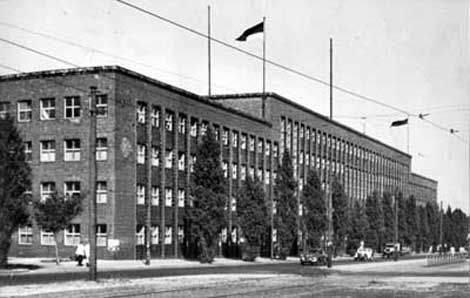 Nordwestdeutscher Rundfunk, 1945
Nordwestdeutscher Rundfunk, 1945
During the time Schaeffer was conducting his experiments in Paris, wider thoughts on electronic music had also opened in Germany, albeit ones diametrically opposed to the free flowing experimentation of the French. Based at the Nordwestdeutscher Rundfunk (Northwest German Broadcasting, or NWDR Studio) in Cologne, the movement focused on “pure” electronic music which eschewed found sound, or indeed any kind of imitative musical sound altogether. Rather, the music made at the studio was an austere and disciplined exploration into hyper controlled electronic synthesis. The sine wave oscillator was chosen as the instrument of choice, and Dr. Werner Meyer-Eppler, a Director of Phonetics at Bonn University, was a main driving force. His interest in the possibilities of electronic sound was keenly stoked after being presented with a prototype Vocoder in 1948. Meyer noticed that it was the detecting of energy levels of sound source over the entire audio frequency spectrum that drove the Vocoder — a primitive artificial talking device.[9]
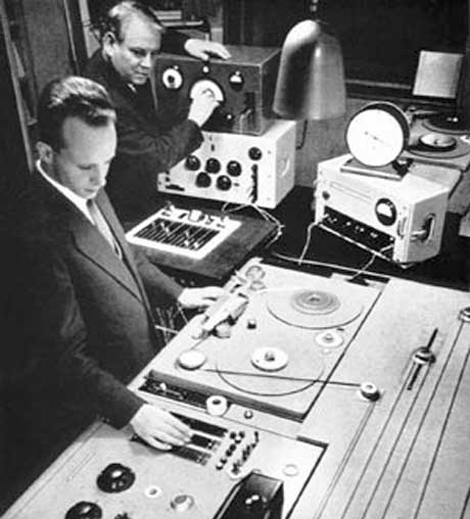
Herbert Eimert and engineer, Leopold von Knobelsdorff
Synthesis, then, was the reverse process — achieved by scanning graphs displaying shaded representations of timbres, and supplying those values to the feedback networks of the analytical filters, which were in turn energized by a noise generator.[10] And it was synthesis that formed the strong backbone of Elektronische Musik. Homer Dudley — a research physicist — and Herbert Eimert — a composer — joined forces with Eppler, forming an early alliance dedicated to its exploration. Eimert, in particular, wrote extensively, and like Schaeffer before him was deeply concerned that this new form should remain guarded against old-school repetition:
“Here we touch a most widespread misconception: namely, the idea that one can make music ‘traditionally’ with electronic means. Of course one ‘can’; but electronic concert instruments will always remain a synthetic substitute. The fact that practically no music which can be taken seriously, artistically, has been written for electronic concert instruments is due precisely to the fact that its use as either soloist or ensemble instrument does not transcend the old means of performance. New ways of generating sound stipulate new compositional ideas, these may only be derived from sound itself which in its turn must be derived from the general material.”[11]
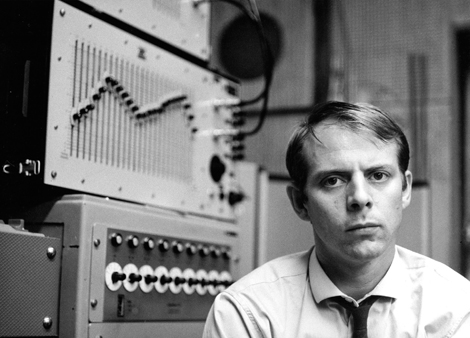
Karlheinz Stockhausen
The nascent form found a champion in composer Karlheinz Stockhausen. Stockhausen had trained briefly under Schaeffer in Paris, and was thus well familiar with sound experiments. But his approach was very different: obsessive and microscopically precise. The sine wave oscillator was capable of breaking sound material down into “sinusoidal” components of different frequencies, amplitudes and tones. The absolute control afforded by the oscillator was revolutionary, but, as touched on earlier, it was the musical philosophy of serialism that was to give Elektronische Musik grounding.
Serialism — or 12 tone music — is a system that is by definition atonal and was devised by composer Arnold Schoenberg with the following rules in regard to any series of 12 adjacent notes: the 12 notes can be arranged in any way, providing no tones are repeated before any others are used; each tone is given equal importance and the tone row may also be reversed.[12]
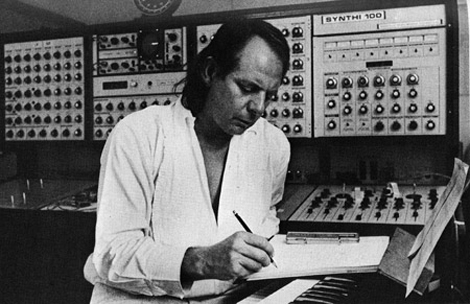
Karlheinz Stockhausen
Stockhausen went further, however, and started to apply these rules not just to notes, but also pitch, dynamic and amplitude. The result was a music that was stunning in its alien otherness, by turns starkly beautiful and chilling. His first piece, “Studie 1,” was written in the NWDR. The resulting piece relies purely on the interplay between frequency and amplitude, and was achieved by recording sine waves onto magnetic tape — two at a time — and then splicing and editing the results.
As time passed however, other machines joined the lone oscillator in the studio. An engineer, Fritz Enkel, was responsible for bringing in devices such as a ring modulator, white noise generator, and band pass filters. These devices ensured that producers such as Stockhausen could continue to innovate with a bank of increasingly sophisticated equipment. Partly as a result, his work became more complex, with haunting pieces such as “Gesang der Jünglinge” incorporating pitch bent vocal fragments for the first time. The resulting piece is a disorientating opus, in which vocalizations are met by bubbling oscillations and violent, jagged bursts of white noise.
“My work on the electronic composition ‘Gesang der Jünglinge’ proceeded from the idea of bringing together into a single sound both sung notes and electronically produced ones: their speed, length, loudness, softness, density and complexity, the width and narrowness of pitch intervals and differentiations of timbre could all be made audible exactly as I imagined them, independent of the physical limitations of any singer.”[13] Karlheinz Stockhausen
The studio was in operation until 2000, when the building was sold. Stockhausen himself worked ceaselessly and often controversially until his death in 2007. But while Elektronische Musik was seen as a vehemently difficult avant garde form, dedicated to literally pushing the envelope of music technology, the Radiophonic Workshop were incorporating similar techniques for commercial ends and mass consumption in London.
The BBC Radiophonic Workshop and Daphne Oram
The Radiophonic Workshop was set up in 1957 specifically for the production of electronic effects and sound tracks for radio and television and quickly cemented a reputation as one of the most vital and creative hubs for electronic music in the world. The studio was in operation because the demand for experimental sound in post war programming was so high; the BBC was now producing innovative dramas on a mass scale, and the need for music to soundtrack dramatic incident — from the romantic to the terrifying — was uncommonly high.
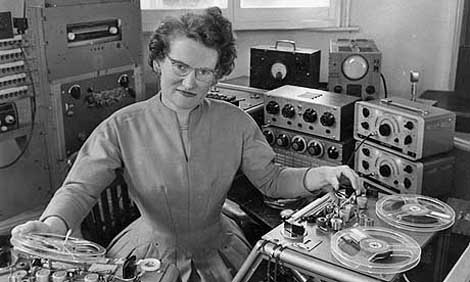
Daphne Oram
Daphne Oram founded the workshop. A BBC producer with a keen appetite for innovative sound design, Oram had been enraptured by Musique Concrète, going so far as to visit Pierre Schaffer at the RTF in Paris during the 1950s. On her return to London, she campaigned for the BBC to set up a similar facility in London. Although only in charge of the Workshop for little over a year, she experimented a great deal during her time.
The Radiophonic Workshop became known for producing extraordinarily imaginative results from limited means. Oram had to fight to persuade BBC bosses of the merits of opening the Workshop and, once opened, she was not furnished with anything approaching the professional machinery of Paris or Cologne. Much of the equipment was creaking and rudimentary, and during the first year Oram had to borrow equipment from other studios at the BBC to use through the night. Nonetheless, exceptional work was produced. Indeed, listening back now it seems hard to believe that music of such vehement imagination was drip-fed into the popular subconscious during prime time programming. Fighting her tight budget, Oram rigged up a rudimentary reel-to-reel tape machine and set to work. Her first groundbreaking work was recorded in 1957, the soundtrack to TV show “Amphytryon 38.”
Perhaps the best-known piece of music to emerge from the Radiophonic Workshop — perhaps the most widely known piece of early electronic music of all time — was Delia Derbyshire’s version of Roy Granger’s theme for “Dr. Who,” an iconic work that married instantly recognizable melody with morphing analogue oscillator tones. Derbyshire was an engineer who had studied music at Cambridge University and was responsible for much of the music produced by the Workshop during the 1960s, although often the credit simply read, “special sound by BBC Radiophonic Workshop.”
Derbyshire’s music was perhaps the most accessible — certainly the most keenly melodic — of the Radiophonic producers. She had this to say about the advent of the Workshop in a rare 1999 interview:
“The BBC was very wary, increasingly being run by committees and accountants, and they seemed to be dead scared of anything that was a bit unusual. And my passion is to make original, abstract electronic sounds and organize them in a very appealing, acceptable way, to any intelligent person. But it was set up as a service to the drama department. It was nothing to do with music, and that’s it. The boss man [at the BBC] had said that “it’s impossible for electronic music to be beautiful… until Delia came along.”[14]
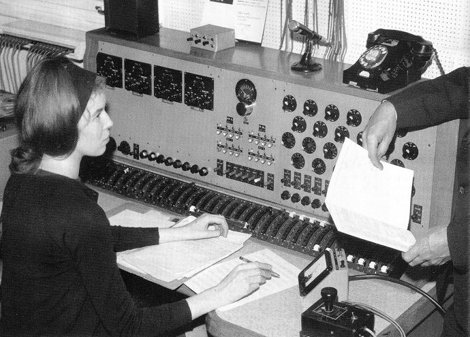
Delia Derbyshire
However, it was Daphne Oram who performed some of the more obtuse and discordant experiments, although it should be noted that recording television soundtracks was assuredly not her true calling. Like Schaeffer and Stockhausen, her primary interest lay in the seemingly boundless musical possibilities afforded by new technology. She envisaged a machine, elegant in conception that would be able to marry both synthesis and composition at once, predating the modern DAW by a good 40 years. This machine was to enable users to “write” in musical data — functionality users of any DAW will take for granted — but something that was utterly revolutionary in the 1950′s.
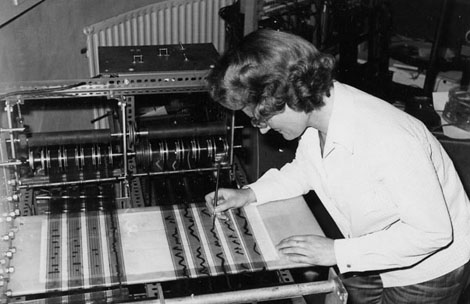
Daphne Oram working with Oramics
The Oramics machine, as it came to be known, used a combination of analogue and digital technologies to allow users to physically draw on each parameter of sound — timbre, pitch, volume, vibrato, reverb — onto individual film strips which was then rendered as voltage control signals; it was built to her specifications by engineer Graham Wrench. In his 2011 article for The Wire, Dan Wilson wrote extensively on the holistic and spiritual aspect to Oramics:
“A waveform would be obtained from a cathode-ray tube scanning unit, fed with a plate containing the drawn waveshape. Wrench specified that multiple scanners could contain different waveforms that, when mixed according to the Oramics control interface, would build up complex waves. Timbre could be changed within a single note…. The Oramics equipment provided a holistic approach to sound, whereas conventional synthesizers offered merely a linear approach, with chains of modules connected in a sequence. The machine allowed for close analysis of the interactions between different parameters, and the subsequent modification or amplification of any unpremeditated interplay. These studies led her to explore the outer reaches of human perception.”[15]
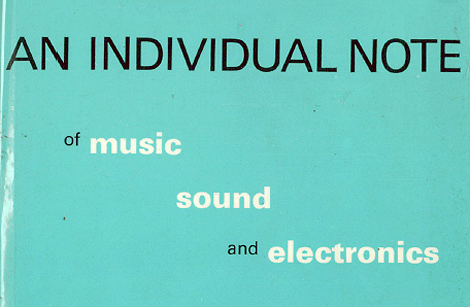
Oram herself also published a book in 1972 that solidified her views on the complex interplay between science, technology, music and personal spirituality — An Individual Note of Music, Sound and Electronics. A fascinating and insightful read, the book is a deeply spiritual, humorous and wildly experimental tome, not only setting out her approach but also revealing a highly skilled and original writer. Here, she sums up her hopes:
“The processes and the machines which the scientists and the engineer bring into being can so easily dwarf man’s individuality, whereas the music of the great composers serves to enhance mans individuality. Can we in the future find some way to nurture the celestial so that it can be transduced into the material world in new forms… forms which will embody all of the greatest attributes of the arts.”[16]
Happily, much of the music produced by Daphne Oram was subtle, nuanced and resolutely human, although it often carried a fantastical and eerie quality. Disembodied voices, pitch bent footsteps and natural sounds sprung from her interest in Musique Concrète, and were combined with a keen sense of melody honed by writing for rote at the Radiophonic Workshop. A piece such as “Dr Faustus Suite” simply hums with dread atmosphere, sinister tone and black humor — check the ghost ship echo, gated air raid sirens and disembodied laughter. But more than that, the piece sounds remarkably fresh, especially when taken in the context of recent fascination for all things haunted and decayed within electronic music.
Enthusiasts’ Perspectives
Indeed, the past half-decade has seen a noticeable trajectory emerge. A growing number of artists, such as Ekoplekz, Demdike Stare, Shackleton, and Raime, to name a few — have imbued their music with an experimental analogue aesthetic that is audibly — if not always intentionally — linked to the music made by early pioneers such as Oram. Dusky, haunted tones proliferate; machinery at play; rude mechanicals; and ghost hardware. Record labels such as Trunk, Ghost Box and Mordant Music have taken perhaps a more direct interest — unearthing hidden gems, and releasing inventive new music that extensively samples and references early electronics.
The last words here go to Jim Jupp of Ghost Box Records and Sean Canty of Demdike Stare, both prolific collectors of early electronic music. Happy digging.
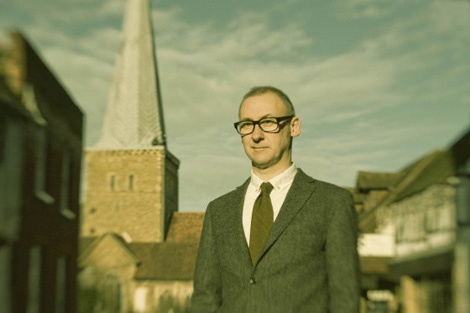
Jim Jupp
“I can only speak for my own peers and friends in “non-dance music” electronics, but I would say for all of them — particularly in the UK — the prime movers are The BBC Radiophonic Workshop. It’s electronic music that’s deeply ingrained, and far more familiar even then the likes of Kraftwerk, to any one in the UK who was a child at any period from the early 60s to the late 80s. Anyone younger, or not from the UK, who is remotely interested in electronic music would also surely be familiar with various re-issues and citations from other labels and artists. Most children get exposed to electronic music through television music before they are old enough to even take an interest in popular music; in Ghost Box we’re fascinated how this music seeps into the unconscious and lurks in the memory, where it can trigger uncanny emotions many years later.
Of course at a nuts and bolts level there’s the equipment that has been developed — early on electronic artists were by necessity inventors and tinkerers — and those innovations have come down to us in evolved forms, in the vast array of accessible and affordable hardware and software now available to the musician. Even over the years I’ve been involved with electronic music in the recording studio, I’m very much aware of how much less time has to spent on troubleshooting and repairs to free up time for sheer creativity. At an artistic level I think we can see with hindsight that the 60ish years of electronic music that’s unfolded has revealed that it evolves like all other musics. And despite the majority of that history being all about striving for the future and utter newness, real development comes as it does in all other art forms by keeping one eye on the past as well as the future. A process of simultaneous innovation and retrospective influence.
I’d also add that I think the idea of “electronic music” is pretty much meaningless these days. It’s a term I use myself, but all sorts of people involved in music production or performance in a huge variety of genres and at all levels of professionalism tend to use at least one item of sophisticated electronic equipment on a regular basis (even if its a portable digital recording or playback device), to the extent that I’d say pretty much everything apart from non amplified acoustic music is “electronic music.”
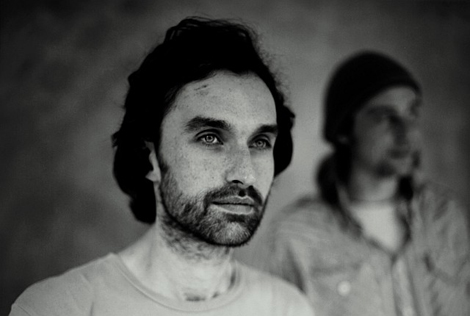
Sean Canty
“I became interested in early electronic music through sound effects in “Dr. Who,” as well as Kraftwerk and labels like Command. There were also the early Moog records. I was bored of chasing the same records as everybody else and increasingly fascinated with trying to find non-U.S. records. Eventually I came across the world of library music and early avant garde electronic music; labels such as Music De Wolfe, L’IIIustration Musicale and KPM were my introduction. I was also lucky enough to find a copy of the Electrosonic LP, a record originally made for a ballet by Pierre Henry, in a used record store in Manchester. This all led me to more illusive records by the likes of Iannis Xenakis and Giampiero Boneschi.
Things have really opened up with the help of labels such as Young Americans, Finders Keepers and Trunk Records releasing the music of Daphne Oram, Suzanne Ciani and Desmond Leslie. People can now hear how incredibly relevant and inspiring this music really is. What fascinates me is that much of the music was never even intended for commercial release. This faceless music — free of major record label campaigns and photo shoots and with no compromise whatsoever — was often just musicians trying to create whatever came into their heads. It maybe the purist form of musical expression, and something I strive for everyday of my life.”
Footnotes:
[1]BBC Radiophonic Workshop Producton, Private Dreams and Public Nightmares, Daphne Oram and Frederick Bradnum, produced by Donald McWhinnie, 7/10/1957.
[2]Ferruccio Besoni, Sketch of A New Esthetic of Music available online: http://www.archive.org/stream/sketchofanewesth000125mbp/sketchofanewesth (accessed 3/18/2012)
[3]Luigi Russolo, The Art of Noise, available online: http://www.paulj.myzen.co.uk/blog/futurism/?page_id=354 (accessed 4/17/2012)
[4]Tim Hodgkinson, An Interview with Pierre Schaeffer, May 2, 1986, ReR Quarterly Magazine, Volume 2, Number 1, 1987, available online: http://www.timhodgkinson.co.uk/schaeffer
[5]Peter Manning, Electronic and Computer Music, Oxford University Press, 2004, p.20.
[6]Thom Holmes, Electronic and Experimental Music, Third Edition, Routledge, 2008.
[7]ibid, 50.
[8]Hodgkinson, An Interview with Pierre Schaeffer.
[9]Manning, p.49
[10]Manning, p.39.
[11]Herbert Eimert, What is Electronic Music, Die Reihe, Vol 1, 1957, available online: http://www.scribd.com/doc/7396247/Herbert.
[12]Holmes, p.59
[13]Karl H Worner, Stockhausen: Life and Works, University of California Press, 1973 p.40
[14]Sonic Boom, An interview with Delia Derbyshire, Surface Magazine, May 2000, available online: http://www.delia-derbyshire.org/interview.surface.php.
[15]Dan Wilson, Daphne Oram: The Woman from New Atlantis, The Wire, issue 330, August 2011.
[16]Daphne Oram, An Individual Note of Music, Sound and Electronics, 1972


















